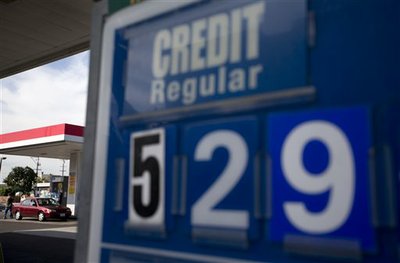
Brown steps in to reduce state gas prices
Morgan Lee, Diana McCabe
Gov. Jerry Brown took emergency action Sunday hoping to quickly drive down gas prices, which skyrocketed almost 50 cents across California in a week.
Brown directed the California Air Resources Board to increase the fuel supply by allowing the immediate production of the more abundant winter blend of gasoline used in California.
The state doesn’t typically switch to its winter blend, which contains butane, until Nov. 1. Moving up the date will release any stockpiled winter-blend gas, and allow refiners to make between 5 percent to 10 percent more gas per unit of oil.
“It’s like adding a refinery overnight, and (prices) should start coming down by Tuesday,” said Dave Hackett, an industry analyst with Stillwater Associates in Irvine.
Approval by the Air Resources Board marks the first time in California history that the state has granted a waiver to switch to winter blend fuel earlier than usual because of a spike in prices, Hackett said. He expects that refiners were working on the blends Sunday night and that the new fuel could be at stations on Monday.
In Mission Valley, Justin Kang of El Cajon pulled into gas station Sunday night where regular gasoline was selling for $4.97 a gallon. “We were just talking about how expensive it is,” he said. “Is there somewhere else that’s cheaper?”
He said the price has pinched his driving habits and forced him to avoid filling his tank all the way. Kang was said everyone hopes Brown’s move works.
“If it went down like $1, that would be great,” he said.
Summer blends resist evaporation during warm weather to reduce smog. Charles Langley, a public advocate with the San Diego based Utility Consumers’ Action Network, said environmental concerns are falling by the wayside because record gas prices can quickly have a ripple effect on the economy, consumer confidence and even political sentiments.
“The governor is calling the oil industry’s bluff,” Langley said. “He’s saying, ‘OK you got what you wanted ... now lower the fuel prices.’”
The historic jump in fuel prices was spurred by an outage Monday at Exxon Mobil's Torrance refinery, which produces 8 percent of the state’s fuel supply.
Also on Monday, a Chevron pipeline that carries crude from Kern County to Northern California refineries was shut down after elevated levels of organic chloride were detected in the oil. Chevron’s Richmond plant, the largest refiner in Northern California, has also been running at reduced capacity since a fire Aug. 6.
Even though the Torrance refinery was starting to come back online, Brown didn’t want to wait for any more price increases or supply issues, saying it could cause “unacceptable price impacts for consumers and small businesses, significant economic disruption, and serious harm to public safety and welfare.”
“Allowing refiners to make an early transition to winter-blend gasoline could quickly increase fuel supply and provide a much needed safety valve with negligible air quality impacts,” Brown said in a statement.
San Diego gasoline prices jumped 19 cents Thursday into Friday, and records were set this weekend. AAA reported Sunday that the county average for a gallon of regular was $4.71, breaking Saturday’s high of $4.674. The weekend prices are the highest since June, 19, 2008, when the record was $4.63. A year ago, consumers paid $3.799 at the pump.
The state’s average jumped to a record of $4.655 this weekend, up almost 50 cents from the previous week, AAA figures show. A year ago, the state average for regular was $3.803.
The sudden spike, while prices fell in other regions of the country, underscored vulnerabilities in California’s fuel supply.
Sen. Dianne Feinstein, D-Calif., on Sunday asked the Federal Trade Commission to investigate whether gas prices in the state were being illegally manipulated.
“Something is wrong with the market,” said UCAN’s Langley. “The market isn’t functioning properly.”
“This is an extreme event,” Hackett said. “There is a lot of head scratching over this because of the extreme volatility that occurred in the market. People will be going over the data in the next few weeks to see if maybe it was more than just (refinery problems).”
Some gasoline station owners in Southern California ran out of fuel or closed temporarily because of the super tight gasoline supplies.
Just how fast will prices come down?
Hackett thinks they could drop as fast as they went up. On Friday, prices on the spot market had already dropped 46 cents, he said. Consumers should start to see that decline at the pump in the next few days. In previous price spikes, consumers have said prices rise quickly but drop back slowly.
In some locations, fuming motorists paid $5 or more per gallon. Sunday Gasbuddy.com showed the highest price in the county at $5.79 for a gallon of regular at a station in Escondido. The lowest price? A station in south San Diego showed $3.99 but most of the updated prices were in the $4.40 range.
Anthony Biondo, who commutes about 85 miles a day between Fallbrook and La Jolla, was buoyed by the governor’s announcement — even though he doesn’t figure it will influence the price of his next gas purchase on the way to work Monday morning.
“My hope is it would come down and it would be effective immediately — not only for consumers, but to save jobs” at gas stations, he said. “By next week if there was a reduction of 15 to 20 cents, that would be a sign that it was … going in the right direction.”
AAA's Daily Fuel Gauge report said the national average both Saturday and Sunday was about $3.81 a gallon, the highest ever for this time of year. However, gas prices in many other states have started decreasing, which is typical for October.http://www.utsandiego.com/news/2012/oct/07/govenor-steps-reduce-ca-gas-prices/?print&page=all

